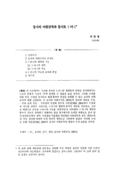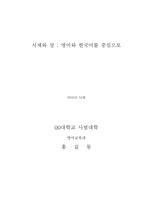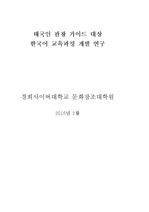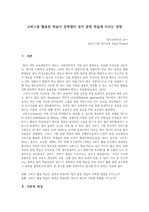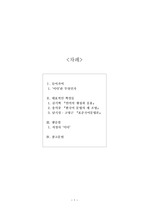

-
 * 본 문서는 배포용으로 복사 및 편집이 불가합니다.
* 본 문서는 배포용으로 복사 및 편집이 불가합니다.
미리보기
서지정보
· 발행기관 : 우리말학회
· 수록지 정보 : 우리말연구 / 15권
· 저자명 : 서민정
목차
1. 들어가기
2 동사의 어휘규칙과 동사토
3. { 더-}의 제약과 기능
3.1. { 더-}의 제약
3.2. {-더-}의 기능
4. {-더-}의 기능과 동사와 문장
5 마무리초록
이 논문에서는 우리말 봉사토 {-더-}를 형태론적 단위로 분석하면서도
그것의 문법적 기능이 ‘구’에 반영될 수 있음을 보일 것이다. 그러한 논의를
위해 먼저, 우리말 동사토의 형태·통어적 특성을 반영할 수 있는 동사의 어휘
규칙에 대해 설명한다 이 동사의 어휘규칙은 HPSG의 원리에 바탕을 두되,
- 특히 토와 같은 - 우리말의 특성에 맞도록 서민정(2003, 2004)에서 수정하
여 제시한 것이다. 다음으로, {-더-}의 형태적·통어적 제약을 검토하고, 그것
을 바탕으로 분석된 {-더-}의 기능을 ‘자질구조’로 나타낸다. {-더 }의 제약과
통어적 기능을 파악하기 위해서는 앞선 연구에서의 논의를 바탕으로 동사 줄
기 안맺음토와의 제약, 마침법토·이름법토·매김볍토 이음법토와 같은 맺음토와
의 제약, 임자말·어찌씨 등의 통어적 제약으로 구분하여 살핀다. 이러한 논의
를 통해 서민정(2003, 2004)의 동사의 어휘규칙과 형판이 수정·보완될 것이다.영어초록
I disscussed the morphologic and syntactic constraints and fuction of Korean
inflectional affixes -teo-(더). I introduce the method and principle of HPSG for its
discussion. First, I add a new morphological unit to the sub-classification of sign
in P&S (1984) and establish the schema for the morphological unit. And I explain
that the Korean inflectional affixes unite the Korean verb stem and other
inflectional affixes as a agglutination and linguistic information of Korean
inflectional affixes unite the linguistic information of Korean verb stem and other
inflectional affixes as the principle of unification. The feature of {-더-} is
'cognition', and the feature structure of {-더-} is (1).참고자료
· 없음태그
-
자료후기
-
자주묻는질문의 답변을 확인해 주세요

꼭 알아주세요
-
본 학술논문은 (주)학지사와 각 학회간에 저작권계약이 체결된 것으로 AgentSoft가 제공 하고 있습니다.
본 저작물을 불법적으로 이용시는 법적인 제재가 가해질 수 있습니다. -
해피캠퍼스는 구매자와 판매자 모두가 만족하는 서비스가 되도록 노력하고 있으며, 아래의 4가지 자료환불 조건을 꼭 확인해주시기 바랍니다.
파일오류 중복자료 저작권 없음 설명과 실제 내용 불일치 파일의 다운로드가 제대로 되지 않거나 파일형식에 맞는 프로그램으로 정상 작동하지 않는 경우 다른 자료와 70% 이상 내용이 일치하는 경우 (중복임을 확인할 수 있는 근거 필요함) 인터넷의 다른 사이트, 연구기관, 학교, 서적 등의 자료를 도용한 경우 자료의 설명과 실제 자료의 내용이 일치하지 않는 경우
“우리말연구”의 다른 논문도 확인해 보세요!
-
주제어와 대조초점 - 어순 및 강세와 관련하여 - 24 페이지
우리말에서 도움토씨 ‘-는’은 주제어와 대조의 두 기능을 가지는 것으 로 기술되어 왔는데, 이륜 간추리면 다음과 같다. 보동 ‘ 는’ 생분이 월머리에 놓이면 주제어로 해석되는데 월머리에 놓인 ‘一는’ 성분일지라도 강세가 부여 되면 대조초점으로 해석된다 그런데 이러한 논의가 재대로 검증되가 위해서는, 어순이나 강세가 한국어 에서 차지하는 역할에 대하여 염멸하.. -
"됐어"의 화용적 기능 18 페이지
이 논문은 대화에서의 ‘됐어’의 화용적 기능을 밝히는 데 목적이 있다 대화에서의 ‘됐어’는 ‘-이 이루어지다’라는 기본의미에서 멸어졌으며, 모자란 월이면서도 다양한 기능을 가지고 있다 ‘됐어’의 화용적 기능은 선행발화에 따라 수락 표시의 기능, 발화 중지 요청의 기능, 거절 표시의 기능으로 분류 된다. 이상의 수락, 중지, 거절의 기능을 가진 ‘됐어’는 활.. -
소유풀이씨 "가지다"의 원형과 확장 구조 22 페이지
소유풀이씨 ‘가지다’는 으뜸풀이씨에서, 도움풀이씨, 토씨, 담화표지로 문법화하는 것으로 나타난다 으뜸풀이씨로서 소유물이 구체적인 것에서 추상 적인 것으로 확대되는 것은 ‘은유’에 의해서 설명이 가능하다. 또 까지다’가 [소유 획득]과 [소유 지속]이 시간적 인접성에 의한 환유에 의해서 두 가지로 해석되므로 [A'B]로 요약할 수 있다. 다응 ‘가지다’의 소.. -
종결어미 "-니"의 기능과 의미 26 페이지
우리말은 세계에서 유래를 찾기 어려울 정도로 종결어미가 발달된 언 어이다. 이렇게 종결어미가 발달된 것은 우리말을 사용하는 언어대중의 의식 속에 종결어미에 대한 구분의 필요성을 강하게 느끼기 때문이다. 이러함에도 서구 언어이론의 틀 속에서 우리말의 체계화를 논의하고 있기 때문에 종결어 미에 대한 체계화는 아직 만족할 만한 단계에 이르지 못하고 있다. 특히 .. -
한국어 금기어 연구 -유형과 실현 양상을 중심으로- 27 페이지
이 논문의 목적은 금기어플 언어학적으로 분석하는 데에 있다. 이를 위하여 금기어의 개념을 언어학적 관점에서 재검토하고 이를 바탕으로 금기 어 개념을 정립하고 금기어의 유형과 실현 양상을 살펴보았다 언어학의 연구 대상으로서의 금기어는 언중의 특정 행동에 대한 금기나 특 정 행동을 금기하는 언어 표현(‘금기담’, ‘통사적 금기어’)은 제외되어야 한다 언어학적 ..
찾으시던 자료가 아닌가요?
지금 보는 자료와 연관되어 있어요!
문서 초안을 생성해주는 EasyAI
